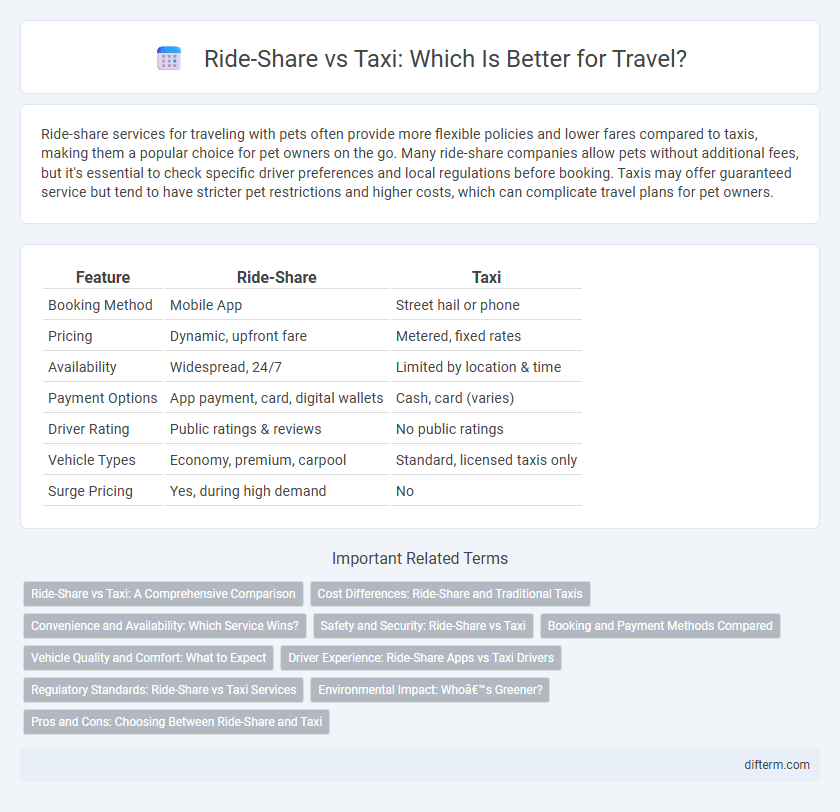Ride-share services for traveling with pets often provide more flexible policies and lower fares compared to taxis, making them a popular choice for pet owners on the go. Many ride-share companies allow pets without additional fees, but it's essential to check specific driver preferences and local regulations before booking. Taxis may offer guaranteed service but tend to have stricter pet restrictions and higher costs, which can complicate travel plans for pet owners.
Table of Comparison
| Feature | Ride-Share | Taxi |
|---|---|---|
| Booking Method | Mobile App | Street hail or phone |
| Pricing | Dynamic, upfront fare | Metered, fixed rates |
| Availability | Widespread, 24/7 | Limited by location & time |
| Payment Options | App payment, card, digital wallets | Cash, card (varies) |
| Driver Rating | Public ratings & reviews | No public ratings |
| Vehicle Types | Economy, premium, carpool | Standard, licensed taxis only |
| Surge Pricing | Yes, during high demand | No |
Ride-Share vs Taxi: A Comprehensive Comparison
Ride-share services such as Uber and Lyft offer dynamic pricing, app-based booking, and real-time tracking, often resulting in lower fares compared to traditional taxis. Taxis provide regulated rates, dedicated street hailing, and driver familiarity with local routes, ensuring reliability in certain urban areas. Both options vary in availability, convenience, and cost-effectiveness depending on city infrastructure and passenger preferences.
Cost Differences: Ride-Share and Traditional Taxis
Ride-share services typically offer lower base fares and dynamic pricing that adjusts based on demand, often making them more cost-effective for short to medium trips compared to traditional taxis. Traditional taxis usually have fixed rates regulated by local governments, which can result in higher costs during peak hours or in heavy traffic due to metered pricing. Consumers seeking budget-friendly transportation often prefer ride-shares because promotions, discounts, and lower minimum charges reduce overall travel expenses.
Convenience and Availability: Which Service Wins?
Ride-share services like Uber and Lyft offer greater convenience with app-based booking, real-time tracking, and cashless payments, making rides accessible anytime and anywhere. Traditional taxis provide immediate availability in busy urban areas and regulated pricing, ensuring reliability during peak hours and in less connected locations. Overall, ride-share wins in convenience due to technological integration, while taxis maintain strong availability in specific situations and regions.
Safety and Security: Ride-Share vs Taxi
Ride-share services implement GPS tracking, driver background checks, and real-time ride monitoring to enhance passenger safety, often allowing users to share trip details with trusted contacts. Traditional taxis typically operate under stricter local regulations, with licensed drivers subject to continuous oversight, providing established security protocols. Both options have safety measures, but ride-shares offer advanced technology features while taxis benefit from regulated licensing systems.
Booking and Payment Methods Compared
Ride-share platforms allow users to book rides instantly through mobile apps, offering seamless integration with digital wallets and multiple payment options like credit cards, PayPal, and in-app credits. Taxi services typically require phone or street booking, though many now offer app-based reservations and accept card payments alongside cash. Ride-shares provide transparent fare estimates and cashless transactions, enhancing convenience and reducing wait times compared to traditional taxi payment methods.
Vehicle Quality and Comfort: What to Expect
Ride-share vehicles often vary widely in quality and comfort since drivers use personal cars, ranging from economy models to premium sedans, whereas taxis typically maintain a consistent standard with regular inspections and professional fleet management. Air conditioning, cleanliness, and seating comfort in ride-shares depend heavily on the individual driver, while taxis are generally designed for durability and frequent use, sometimes compromising plushness for practicality. Passengers seeking luxury or guaranteed vehicle standards may prefer ride-share services offering premium options like Uber Black, while those prioritizing reliability and regulated safety standards might opt for traditional taxis.
Driver Experience: Ride-Share Apps vs Taxi Drivers
Ride-share drivers often enjoy flexible schedules and the ability to use personal vehicles, enhancing job autonomy compared to traditional taxi drivers who typically adhere to fixed shifts and lease taxi medallions. Ride-share platforms provide drivers with in-app navigation, real-time ride requests, and automated payment systems, streamlining the operational experience versus conventional taxi dispatch methods. Customer rating systems in ride-share apps directly impact driver earnings and motivation, unlike the less transparent feedback mechanisms in the taxi industry.
Regulatory Standards: Ride-Share vs Taxi Services
Taxi services are typically subject to stringent regulatory standards, including fixed fare structures, mandatory licensing, and regular vehicle inspections, ensuring passenger safety and fare transparency. Ride-share platforms operate under more flexible regulations, often varying by region, which can lead to discrepancies in oversight, insurance requirements, and driver background checks. These regulatory differences impact consumer protections, pricing models, and service accountability within urban transportation networks.
Environmental Impact: Who’s Greener?
Ride-share services often reduce environmental impact by maximizing vehicle occupancy and utilizing electric vehicles, leading to lower per-passenger emissions compared to traditional taxis. Studies show that ride-shares decrease the number of single-occupancy trips, which helps reduce traffic congestion and air pollution in urban areas. However, taxis frequently use hybrid or electric models in some cities, narrowing the environmental advantage between the two options.
Pros and Cons: Choosing Between Ride-Share and Taxi
Ride-share services offer convenience, often lower costs, and easy app-based bookings, making them ideal for tech-savvy travelers seeking flexibility. Taxis provide regulated pricing, immediate street hailing, and experienced local drivers, ensuring reliability in areas with limited internet access. Choosing between ride-share and taxi depends on factors like cost, availability, safety preferences, and travel destination-specific regulations.
ride-share vs taxi Infographic

 difterm.com
difterm.com